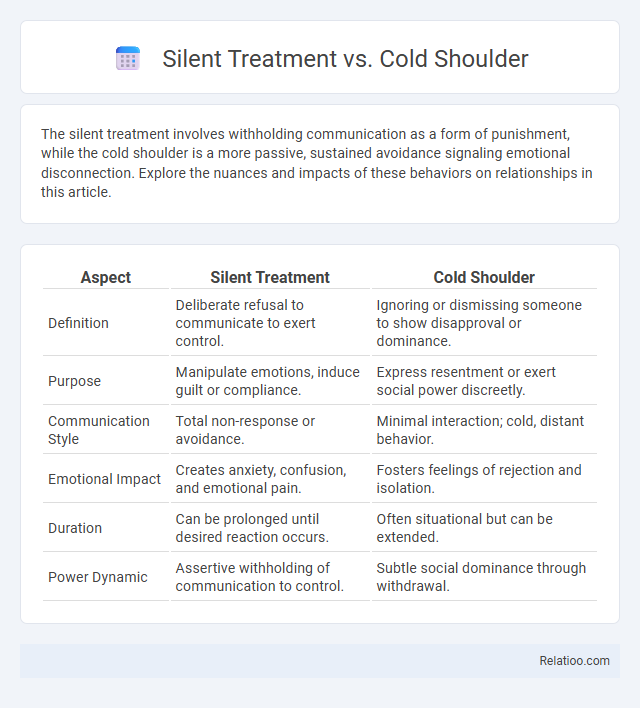The silent treatment involves withholding communication as a form of punishment, while the cold shoulder is a more passive, sustained avoidance signaling emotional disconnection. Explore the nuances and impacts of these behaviors on relationships in this article.
Table of Comparison
| Aspect | Silent Treatment | Cold Shoulder |
|---|---|---|
| Definition | Deliberate refusal to communicate to exert control. | Ignoring or dismissing someone to show disapproval or dominance. |
| Purpose | Manipulate emotions, induce guilt or compliance. | Express resentment or exert social power discreetly. |
| Communication Style | Total non-response or avoidance. | Minimal interaction; cold, distant behavior. |
| Emotional Impact | Creates anxiety, confusion, and emotional pain. | Fosters feelings of rejection and isolation. |
| Duration | Can be prolonged until desired reaction occurs. | Often situational but can be extended. |
| Power Dynamic | Assertive withholding of communication to control. | Subtle social dominance through withdrawal. |
Understanding the Silent Treatment
The silent treatment involves deliberately ignoring or refusing to communicate with someone to express displeasure, often as a passive-aggressive tactic. The cold shoulder is similar but typically warmer in social contexts, where the person may acknowledge presence with minimal interaction or distant behavior. Understanding the silent treatment requires recognizing its emotional impact, as it can cause feelings of rejection, confusion, and strain relationships by withholding communication and emotional connection.
What Is the Cold Shoulder?
The cold shoulder is a deliberate act of showing indifference or disdain by ignoring or avoiding someone, often as a passive-aggressive response within interpersonal relationships. Unlike the silent treatment, which involves complete refusal to communicate, the cold shoulder may include subtle signals such as avoiding eye contact or minimal engagement, emphasizing emotional distance without total silence. This behavior serves as a non-verbal form of rejection, creating emotional discomfort while maintaining some level of interaction.
Key Differences: Silent Treatment vs. Cold Shoulder
The key difference between silent treatment and cold shoulder lies in intent and duration: silent treatment is a passive-aggressive tactic where one deliberately ignores or refuses to communicate to punish or control, often temporarily; cold shoulder involves a deliberate and sustained withdrawal of attention or affection to express disapproval or resentment. Your response to these behaviors should consider the emotional impact, as silent treatment often feels more isolating, while cold shoulder signals ongoing dissatisfaction. Recognizing these distinctions helps you address communication breakdowns effectively and foster healthier interactions.
Psychological Impact on Relationships
Silent treatment inflicts emotional distress by creating a barrier to communication, often leading to feelings of abandonment and confusion within relationships. Cold shoulder behavior contributes to perceived rejection, fostering resentment and weakening emotional bonds due to prolonged disengagement. Both tactics impair trust and intimacy, increasing the risk of long-term relationship deterioration and psychological strain on both partners.
Common Reasons People Use These Behaviors
Common reasons people use the silent treatment, cold shoulder, and similar behaviors include avoiding conflict, expressing anger or disappointment, and seeking control in emotionally charged situations. These actions often serve as non-verbal communication tools to convey dissatisfaction without direct confrontation. Understanding these motives can help you recognize underlying emotions and improve resolution strategies.
Signs You’re Experiencing Either Tactic
Silent treatment often involves complete refusal to communicate, manifesting as prolonged silence and avoidance, while the cold shoulder shows subtle signs like ignoring your presence or giving one-word responses. You might notice emotional withdrawal or a lack of eye contact during the silent treatment, whereas the cold shoulder often includes dismissive body language and minimal engagement. Recognizing these signs helps identify when someone uses these tactics to manipulate or control a situation.
Short-term and Long-term Effects
The silent treatment often causes immediate emotional distress and confusion, leading to anxiety and reduced communication in the short term, while long-term effects include erosion of trust and increased emotional distance. The cold shoulder, characterized by deliberate neglect or ignoring, can provoke feelings of rejection and frustration quickly, with prolonged exposure resulting in diminished relationship satisfaction and potential emotional withdrawal. Silent treatment repeated over time may escalate conflicts and foster resentment, severely damaging intimacy and increasing the risk of unresolved issues affecting overall relationship stability.
Healthy Communication Alternatives
The silent treatment often involves intentional refusal to communicate as a form of punishment, while the cold shoulder is a deliberate disregard or avoidance showing emotional distance. Both behaviors harm relationships by fostering misunderstanding and resentment. Healthy communication alternatives include expressing feelings openly, using "I" statements to avoid blame, and actively listening to promote empathy and resolution.
How to Respond to Emotional Distance
Responding to emotional distance such as silent treatment, cold shoulder, or stonewalling involves recognizing each behavior's intent and maintaining calm communication. Practicing active listening and expressing your feelings without blame helps break the cycle of withdrawal. Setting clear boundaries and seeking mutual understanding fosters reconnection and emotional healing.
Seeking Help: When to Involve a Professional
The silent treatment involves refusing to communicate to punish, while the cold shoulder is a deliberate act of ignoring someone to express disapproval. When these behaviors persistently damage relationships or cause emotional distress, seeking help from a mental health professional is crucial. Therapists can provide communication strategies and coping mechanisms to address underlying issues and promote healthier interactions.

Infographic: Silent treatment vs Cold Shoulder
 relatioo.com
relatioo.com